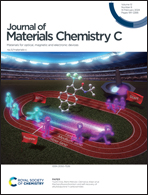Realizing a broad-scope and high-sensitivity optical thermometer based on dual-emission centers with structure confinement effect-related energy transfer†
Abstract
Developing optical temperature sensors with superior performance has become an important but challenging task owing to the increasing temperature monitoring demand under extreme conditions. Herein, for developing luminescence materials with high performance, the energy transfer processes and temperature-dependent photoluminescence properties of Ce3+- and Mn2+-activated K7CaLn2B15O30 (Ln = Lu, Y, Gd) phosphors were comparatively analyzed. On the basis of K7CaLn2B15O30 (Ln = Lu, Y, Gd) hosts with a compacted Ce3+–Mn2+ distance of approximately 3.3 Å, an energy transfer process with high efficiency was achieved by a structural confinement effect. Energy transfer efficiency values between Ce3+ and Mn2+ in the three co-doped systems were in the order ηET(KCLBO) > ηET(KCYBO) > ηET(KCGBO), which could be attributed to the different distances between Ca2+ and Ln3+. Arising from the different local site environments of Ce3+ and Mn2+, the tendency of the photoluminescence thermal stability of Ce3+ and Mn2+ in the three co-doped systems is different. Owing to the diverse sensitivity that Ce3+ and Mn2+ have toward temperature with a faster luminescence dropping rate of Mn2+ than that of Ce3+, a broad-scope optical thermometer based on fluorescence intensity ratio (FIR) was designed. Finally, the optimal relative sensitivity was found to be 3.045% K−1 (at 160 K), and the corresponding temperature resolution was 0.1 K among the three co-doped systems. The resulting spectral adjustability and distinguished sensitivity of the systems based on the site environments of reference and signal ions shed light on the design and development of luminescence materials with high sensitivity for optical temperature sensing.



 Please wait while we load your content...
Please wait while we load your content...